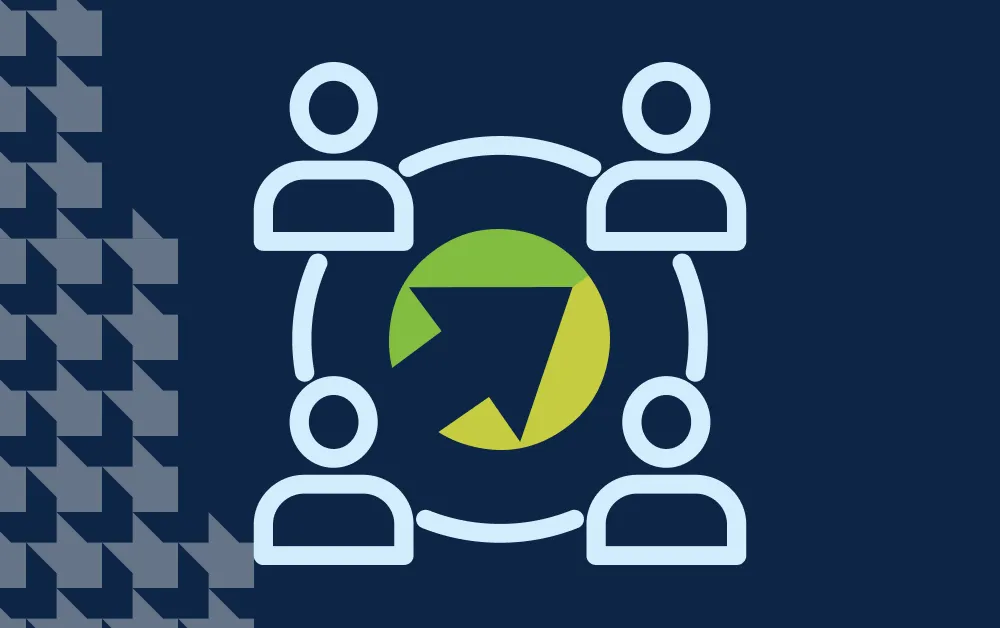About the Episode
Adopting technology that promotes transparency and enables collaboration within their lending and credit teams can be a great benefit for banks and credit unions.
By leveraging loan origination technology, financial institutions can streamline their processes and enhance teamwork. Transparency plays a vital role in breaking down silos and improving collaboration. When all team members have access to the same data, they can work more effectively and efficiently. Additionally, technology enables data sharing, allowing teams to leverage and enhance customer information throughout the lending process. Transitioning to technology-driven collaboration requires effective change management, but the benefits of saving time and improving credit decisions are compelling incentives.
Listen in to learn why embracing technology is essential in today's fast-paced market, as it reduces processing times, increases staff capacity, and delivers exceptional customer experiences.
How Loan Origination Technology Creates Transparency and Enables Collaboration FAQs:
How does loan origination technology enhance collaboration within financial institutions?
Loan origination technology promotes collaboration by providing a centralized platform for lending and credit teams to work together. It enables real-time data sharing, ensuring that all team members have access to the same information, fostering better communication and coordination. This technology streamlines workflows, allowing teams to collaborate seamlessly on loan applications, credit assessments, and decision-making processes.
How does loan origination technology improve transparency in financial institutions?
Loan origination technology increases transparency by capturing and storing data related to loan applications, customer information, and credit evaluations in a centralized system. This enables authorized team members to access and review this information easily. With transparent processes, institutions can track the status of loan applications, identify bottlenecks, and ensure compliance with regulatory requirements. This transparency enhances accountability and builds trust among team members and customers.
Can loan origination technology help financial institutions make more informed credit decisions?
Yes, loan origination technology empowers financial institutions to make better-informed credit decisions. It provides comprehensive data analytics and reporting capabilities that enable lenders to assess creditworthiness accurately. By leveraging technology, institutions can analyze vast amounts of customer data, assess risk factors, and determine appropriate lending terms. This results in more accurate credit decisions, reduced risks, and improved loan portfolio management.
How does loan origination technology contribute to a better customer experience?
Loan origination technology streamlines the loan application process, reducing manual paperwork and accelerating approval times. This faster and more efficient process improves the overall customer experience. Moreover, technology-driven collaboration enables loan officers to provide prompt and accurate responses to customer inquiries. With enhanced transparency, customers can track the progress of their loan applications in real-time, resulting in increased satisfaction and trust in the institution's services.
Transcript
Mitch Woods: Welcome to today's episode of Lending Made Easy. We're gonna talk today about teamwork. You know, at a bank or credit union, there are a lot of people doing things to support the commercial lending process. So today we're gonna dive into how a loan origination technology, can help bring your, your credit and your lending teams together to provide more collaboration and visibility through the entire process.
So Bryan, David, thanks for joining us today on, on the episode. I'll kick it off with the first question. So, if you're a bank or credit union looking to implement a loan origination system or, or other lending technology, what are some things that you want to see as an end result there and, bringing your credit and your lending teams together in helping them collaborate and work better together?
Bryan Peckinpaugh: I'm gonna give you the age old, Salesperson answer. It depends. Yeah. Yeah. It's always a challenging one because it is so dependent on what every institution is looking for. So when we say we want our, constituents in the lending process working better together, that's gonna be a little bit different from one institution to the next.
And it's really understanding from the FI's perspective what it is they are trying to accomplish, you know what, what do you see as the inefficiencies to your process? What do you see as the challenges to serving your end client, who is the borrower? And how can technology solve for that for you? That said, it all boils down to to transparency and, and that's what helps you start to break down the silos.
If everybody has access to the same data, assuming you, you have the actual rights and privileges to see it. cuz there are certain regulatory things you wanna keep from certain steps in the process, but having transparency into whose desk is it on? What stage in the process is it? What's left to be done? Et cetera, allows me to collaborate better.
You know, gone or the days of just banging on the underwriter's door, where's my deal? Where's my deal? Because I can see it. I can potentially see what's in line in front of it, why it's in line, in front of it. Because the more data I have, the more I can self-serve, the, the better the process tends to be for everybody.
But then the, the devil's in the details for each institution as, as to where those friction points are in, in your own process.
David Catalano: Brian, that's exactly what I was gonna say around data, So to me, as I start a deal and I'm informing the organization with new information about the deal I'm working on, and everybody in the process can see that, that's a positive thing to me. So I'm entering information once and I'm using it over and over and over again, which is essentially the way to enhance the capacity of a team so that they're not re-keying the same data over and over and they're not asking for the same thing twice or three times or five times, and they have access to that data pool.
And each person in the process, if you think about it, they're enhancing that data and as they enhance the data, others can benefit and use that information. So if I wanna look at where the deal is in the process and I'm, I'm at the branch level, I can see into that deal, assuming I have the rights to do that, if I'm the relationship manager and I'm pre-flighting a deal and I put my new information in and can update my spreads and my credit memo and use, uses, proceeds and can quickly expedite that through decision makers and get a sense of whether this deal has legs or whether I need to enhance that, and I can do that quickly. That that's a, it's a phenomenal way to improve the customer experience through the sharing of data.
And through the visibility from a solutions perspective, wherever that deal is in the process, the right people can see, what they need to see to make decisions. which enhanced the customer experience. Really what it does is it enhances the employee's experience, which makes a better customer experience because the, if you think about the typical commercial loan, the customer doesn't have much to do in the process relative to the team at the bank.
So I would say data, the data sharing, entering information once and using it, to facilitate your work, whether you're entered it or not, somebody else can, can benefit from that information. I think that would be my take on that. So, you know, the front end of that really screams, customer relationship management or CRM type software.
And I think when people hear of CRM, they think of complex CRM solutions like a Salesforce, and most banks just don't need that. You know, they need to be able to see data that typically resides in core around balances, relationships, data that typically resides in some type of loan origination solution around where the deal sits today.
Data in tracking solutions where you're tracking, pre-close items or post-close items, you know, what do I need to collect and when do I need to collect it? And, and then, you know, data sitting in reporting systems around loan performance, you know, notes, on the, on the contacts, notes on the relationships, notes on the people, the accounts, that sort of thing.
Beyond that, kind of a stretch as to what I'm gonna need that, you know, something more than that. And if you have that, you've got pretty much of a 360 degree view of the client, the relationship, the group of relationships associated with each loan, and you can really run the business effectively that way.
And to me, that's a way to collaborate in a team environment. Sharing the same data, but sharing the data that's important. You know, whenever somebody embarks upon one of these projects, it's important to understand how big is the elephant I'm about to eat? And you know, we we're a company at, at Baker Hill that we went through three implementations of a CRM solution before we got it right. And that was expensive and not something that you'd wanna do as a bank. So, you just wanna make sure you understand what is the solution capable of doing? What am I capable of doing? And how does that fit to the goal I'm trying to accomplish?
Bryan Peckinpaugh: You know, and, and thinking too about where, where this industry has come from. So, gonna date myself a little bit here. You know, when I first started my career working for, a, financial institution, and, and this is only somewhere between 20 and 30 years ago when we were processing commercial loans. When we were working through those processes, you had to walk over to the file room and there was a wonderful woman that worked there and that this was all she did was check files in and out of the file room and, and you'd go up and request a specific loan file and she would give it to you. And now you were the owner of that file. Take it back to your desk and parse through it to, you know, review historical committee approvals, the historical spreads.
We did have spreading software at the time, but you know, when you get a new period, you would enter that into the spreading tool, put the paper into the paper folder, and I can't tell you how many times your, your search, like, where's the, we'll use today as an example. Where's the 2021 financial analysis and you know, come to find out that the last person who checked it out forgot to put that piece of paper back in. Or, you know, you're trying to collaborate to get a loan to committee on Thursday at five and, and you know, the RMs working on something, the analysts are working on other things. The underwriters working on something. Somebody would take a piece and a part and now you're chasing the file to try to put it back together cuz you don't wanna get yelled at when you check it back in. Having software that handles all of that for you so that I don't have to worry about that, that as I'm working a process, I can separate out the pieces of the credit memo that need to be worked on, by the RM, by the analyst, by the underwriter, what have you. Having somebody able to spread while I'm working on everything else and not worrying about cobbling the file back together to to check it in, you know, literally whose desk is it on.
But having a, a queuing system, an assignment system, leveraging that to work not just in serial, but in parallel where you can. And putting the guide rails into the technology to handle that for you, right? So, hey, I'm at a point where I have to go in serial, but now I've hit a part of the process where I can work parallel tracks to be more efficient and, and again, letting the, the software dictate, letting the software handle the assignments and, and bringing everything back to the whole.
Again it wasn't that long ago where none of these concepts existed that you literally were breaking apart a physical file. Shuffling that around an office potentially interofficing it to, to people. Side note, I actually saw an interoffice envelope about two weeks ago for the first time in probably a decade.
You know, that, that have all but been replaced with these technology concepts. And, and that's what starts to again, break down those, those divides, gives everybody that view that, that David and I were talking about of, of where things are, what data's important, et cetera.
Mitch Woods: One of the things that we talk about a lot, and, and Brian, you and I just had a conversation, you know, off the mic, what a couple days ago about this is. You've gotta start somewhere. Right? I highly doubt that there, there's a banker credit union out there that still has someone sitting in a room checking physical files out to people.
But I would guess a lot of 'em probably have a SharePoint folder system or some other technology in place where they're, they're able to share documents. But kind of to your point, it's not helping run that process and, and, and truly helping with the collaboration. It, it may be, sharing some of that data back and forth, but to your point, right, the a a software solution is gonna really help, help you work on your own and then work together as well. I think that's, that's a great point to bring out is, is. Where do you think a bank or credit union would see that very first lift? And, and moving from even an electronic file system where people can work on the same document, maybe in, in tandem to a, a solution that's gonna help them with their workflow and really help with that, that queuing and, and providing the transparency there.
Bryan Peckinpaugh: Well one thing I can tell you is you'll only be as good as your change management. So trying to put something like this into play requires from the top down a, a push towards adoption. I'll use an example where you might have an RM who's used to slapping together an email very quickly with 60,000 foot bullets that they send over to their loan assistant, who then handles the process from there.
If I implement technology that's gonna require them to build the structure of the deal. In the system cuz they're the one who knows it the best to be able to do that. It's changed for that RM and they may not like it because they're used to just firing off an email that takes them no time and then they're back to you know, playing golf with, with their clients. And by asking them to spend the time to build it, I'm saving my organization immense time downstream. And so it's probably worth it to, to the organization to drive that change but you have to articulate it and articulate it appropriately so that they understand, Hey, yes, I'm asking you RM, the, the rainmaker, the person who's bringing in.
The bulk of the revenue for the financial institution. sometimes the people who think they're very special, and deserve to be treated as such, you know? Yes. I'm asking you to spend 15 minutes, 30 minutes that you weren't before, but if you do that, I'm gonna save hours of time on the backend because the system is gonna bring together all of those existing relationships, and I'm not gonna have to go pull exposure data. I'm not gonna have to go do X, Y, and Z. That's where you have to articulate that across the constituencies that you're going to have to act different. You're gonna have to interact different with the system and with your fellow coworkers because it is in the best interest of the organization as a whole.
We'll be able to make faster, better credit decisions. We'll be able to better serve the client base in the long run. It will be better for your sales efforts, if you do so. But that gets back to each, on each institution understanding what is most critical to them in the process. What is the driver for my decision making, because if I haven't thought that through, it's gonna be very hard to articulate it to those people whose cheese is gonna move. That, that are gonna have to do their, their work differently.
And if I don't tell them why you're, you're gonna struggle, you know, it's the, the age old. Are you a bricklayer or are you a cathedral builder? And, and if you articulate that vision, you're gonna get a lot better adoption.
David Catalano: Yeah. I also think for newer people coming in, they're going to be trained on that solution and that approach, so that it's not gonna be the issue, it's the, it's the people that are stuck in the ways in which they're doing things that are, that are gonna be the challenge. Just like anything else, I would start sooner than later.
If, if I was a, an executive at a bank, I, I would not wanna continue to allow manual processes to persist in the organization. You're simply gonna get your clock cleaned. I mean, we have clients that go from 74 days to 34 days for a complex commercial start to finish process, they've cut their time in half.
So that staff now has twice the capacity that staff now can grow in new areas that staff now can create wow experiences for their commercial customers versus asking for the same thing three or four times or taking forever to pre-flight a deal with a a no or a constraint on the deal, de-risking it for the bank.
I mean, just, just so many reasons to begin this process sooner than later. And, and what Bryan and I are talking about in the change management component, that's just table stakes for, for executive management of a bank. If you can't handle, change management, then you know, I would argue there, there are probably other things that are challenging for you as well.
Mitch Woods: Well, David, Bryan, thanks for the conversation today. I think a great topic to talk about for bankers – how do we leverage the technology that's available to, to make work better, to make work easier, and then, that ultimately translates to our, our customer experience as well. So thank you guys for your insights, and thanks everyone out there for listening to today's episode of Lending Made Easy.










